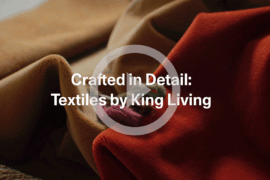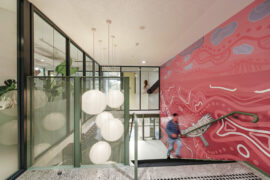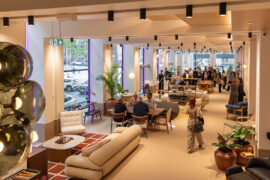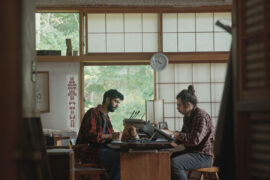Woven Image is offsetting 100 per cent of the embodied carbon emissions of its PET acoustic panel EchoPanel®. Here’s what it means for you and your projects.

April 20th, 2022
Carbon offsetting allows companies to balance out their own carbon footprints by investing in projects that reduce, remove or capture emissions from the atmosphere such as reforestation, renewable energy or energy efficiency. By doing so, they can compensate for emissions they produce and bring their carbon footprint down to zero.
Demonstrating their unequivocal commitment to do better for our environment, Woven Image, pioneers in creating high-performance acoustic finishes using recycled materials, has offset 100 per cent of the upfront embodied carbon of its EchoPanel® acoustic panel portfolio through contributions supporting Greenfleet forests. This is in addition to the contributions the company has made from offsetting their operational carbon emissions since 2017.

Invented and launched by Woven Image in 2004, EchoPanel is the leading eco-friendly decorative interior acoustic panelling solution. Designed to reduce and control reverberated noise in shared environments, EchoPanel® is ideal in a variety of commercial interior spaces, including workplace, education and hospitality environments. EchoPanel is pinnable, lightweight, printable, easy to cut and install, and its colour remains consistent throughout the depth of the panel allowing it to be installed without frames or edging.
Over the years, refinements in the product manufacturing process have ensured EchoPanel® continues to meet and exceed acoustic requirements in even the most challenging of applications, such as open-plan offices and classrooms. Today, the EchoPanel® acoustic panel suite includes 7mm, 12mm and 24mm thick EchoPanel® in up to 33 colourways, precision-cut wall panels and a range of printed panel designs. EchoPanel® is also widely used in workstation, space-dividing and ceiling baffle installations.

While its combination of ‘designer’ surface finishes and performance are unrivalled, EchoPanel’s eco-innovation is what truly sets it apart. Made of 60 per cent recycled PET bottles, every 1,000 sheets of 12mm EchoPanel® diverts 4.8 tonnes of post-consumer waste PET from landfill. EchoPanel boasts a 10-year life expectancy, after which the material is still 100 per cent recyclable.
Offsetting EchoPanel’s carbon to zero is the next step in Woven Image’s sustainability journey. The company has partnered with Greenfleet, Australia’s first carbon offset provider, who are committed to protecting our climate by restoring our forests in Australia and New Zealand. Through donations that continue the restorative and regenerative work of Greenfleet, Woven Image has forward purchased offsets for 2,620 tonnes of CO2-eq for 2022, the equivalent of establishing 4,165 trees.
In 2021 Greenfleet planted 208 different species of native tress across 530 hectares in Australia and New Zealand to sequester 358,178 tonnes of carbon over their lifetime.

EchoPanel’s list of environmental achievements also includes a comprehensive Environmental Product Declaration (EPD), Climate Declaration, and a range of environmental and wellbeing certifications such as Global Green Tag Platinum Health and GreenRate Level A, Low VOC, Red List Free and Declare. Furthermore, EchoPanel® can secure credits under internationally-recognised sustainable building rating tools including Green Star, the WELL Building Standard, and Leadership in Energy and Environmental Design (LEED).

While offsetting EchoPanel’s carbon to neutral is another step forward in their sustainability journey, Woven Image remains committed to delivering against their long-term environmental goals. By 2030, the company is aiming to halve their greenhouse gas emissions while maintaining a positive social impact. They are actively working towards this objective through ongoing investment and research in material innovation, investment in renewable energy, supplier engagement, and continuously innovating in the design, manufacture, installation and distribution of their products.
Woven Image
wovenimage.com

INDESIGN is on instagram
Follow @indesignlive
A searchable and comprehensive guide for specifying leading products and their suppliers
Keep up to date with the latest and greatest from our industry BFF's!

Merging two hotel identities in one landmark development, Hotel Indigo and Holiday Inn Little Collins capture the spirit of Melbourne through Buchan’s narrative-driven design – elevated by GROHE’s signature craftsmanship.

For a closer look behind the creative process, watch this video interview with Sebastian Nash, where he explores the making of King Living’s textile range – from fibre choices to design intent.

From radical material reuse to office-to-school transformations, these five projects show how circular thinking is reshaping architecture, interiors and community spaces.

Designed by Woods Bagot, the new fit-out of a major resources company transforms 40,000-square-metres across 19 levels into interconnected villages that celebrate Western Australia’s diverse terrain.
The internet never sleeps! Here's the stuff you might have missed

Stylecraft opens its new Collins Street showroom, unveiling curated design spaces and Ross Gardam’s Dwell collection.

AHEC has produced a documentary exploring forestry and stewardship through long-term forest management and human responsibility.